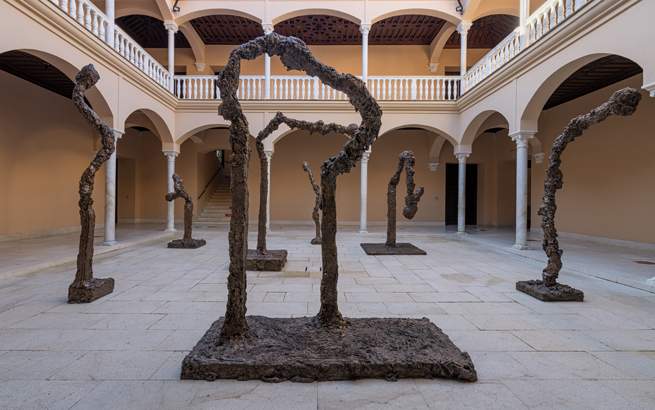Entitled Metamorfosis, the major solo exhibition by Miquel Barceló (Felanitx, 1957) opens today, January 27, at the Picasso Museum in Malaga, Spain. The exhibition, named after Kafka’s famous novel Metamorphosis published in 1915, will run until September 2021 and displays about one hundred works created between 2014 and 2020: for Barceló, it is also a return to Pablo Picasso ’s hometown after an absence of about a decade, and for the occasion the artist is gathering a selection of works of different kinds (thirty ceramics, thirteen paintings, forty-two watercolors, six travel notebooks and a small sculpture, plus an installation of seven large bronzes, Allumettes, which are installed in the museum’s courtyard).
The exhibition, curated by Enrique Juncosa, focuses on the cultural condition of the Majorcan artist, whose works are characterized by transformations, movement, and transitions: his creative world is, in fact, in perpetual metamorphosis, since the beginning of his career. Each of his works leads us toward a new work, in a process of cyclical reinvention: starting from the reality he observes, Barceló lives, reads and imagines his works, which at the same time are imbued with sociological, ecological meanings and convey to the viewer the artist’s passionate, inner life.
And as with Picasso, for Barceló, one of Spain’s greatest contemporary artists, painting and drawing are ways to experiment: “Every work,” says the artist, “is experimental, every work is a test for another, which will probably no longer exist, and I think this is true for my painting, for my ceramics, and for anything that comes out of my hand.” The exhibition has an exceptional venue, the Picasso Museum in Malaga, and Barceló says he received from Picasso “a kind of generic influence, a way of relating to life, a way of being in the world.” There are several elements in common between Picasso’s and Barceló’s art: the constant search, the versatility in seeking new media, the interrelationships between different techniques and different artistic periods, a relentless and dizzying way of working, the dialogue with tradition, the fascination with mythology, the archaic symbolism of bullfighting. And both are two Spanish artists, cosmopolitan and children of the Mediterranean, both creators of a primitive and simultaneously very modern art.
The thirty ceramics constitute the main focus of the exhibition: they are characterized by their sophisticated roughness, with their lacerated, fragmented and sharp forms, where figurative elements appear that refer to plants and beings from the aquatic world, or again to petals, leaves, anthropomorphic forms. The group of ceramics summarizes the interests of an artist who, without ever having abandoned painting, has explored at length and in depth the formal and conceptual possibilities of ceramics. They are creations that originate from his workshop in Vilafranca de Bonany, on the island of Majorca. Also on display in Malaga will be Totems, a new series of large-format ceramics that evoke classical architecture as well as the deities and mythological characters of an unknown civilization.
Then among the large-format paintings are nocturnal landscapes, blues and blacks, with skies that resonate with movement and light. And there is also a singular charred-looking self-portrait, as well as paintings that recall cave painting, one of Miquel Barceló’s great passions. Connected to the title of the exhibition is then a series of fifteen watercolors, made between Thailand and Italy (two countries to which the Majorcan artist has frequently traveled in the past two years), which show a human being turning into an insect. Finally, the seven large-format bronzes represent used and twisted matches after being consumed by fire, and will be installed, as anticipated, in the courtyard of the museum, which has previously featured works by Louise Bourgeois, Bruce Nauman, Alexander Calder or James Turrell.
Miquel Barceló began his career in the 1980s, after studying at the Escuela de Artes Decorativas in Palma de Mallorca and at the Escuela de Bellas Artes Sant Jordi for a few months, and then continued his training as a self-taught artist. He has participated in the Venice Biennale, the São Paulo Biennale in Brazil, Documenta 7 in Kassel, and was awarded the Premio Nacional de Artes Plásticas (1986) and the Premio Príncipe de Asturias de las Artes (2003). His works include the large ceramic retable of Palma de Mallorca Cathedral, created in 2007, and the dome of the Hall of Human Rights and Alliance of Civilizations at the United Nations Palace in Geneva. He has traveled to different countries and areas of the world: Africa, Latin America, Japan, Nepal, France, Italy. Classic artists who have been references for his painting include Caravaggio, Velázquez, Rembrandt, Goya, Paul Klee, Jan Dubuffet, Pablo Picasso, Joan Miró, and Antoni Tàpies.
The exhibition is accompanied by a three-hundred-page catalog with texts in Spanish and English. For info on the exhibition you can visit the website of the Picasso Museum in Malaga.
Image: Miquél Barceló, Allumettes I, III, IV, V, VIII, IX, XIII (2015; bronze; Collection of the artist). Photo: Pablo Asenjo © Museo Picasso Málaga © Miquel Barceló, VEGAP, Málaga, 2021
 |
| A major solo exhibition by Miquel Barceló opens at the Picasso Museum in Malaga, with about 100 works |
Warning: the translation into English of the original Italian article was created using automatic tools. We undertake to review all articles, but we do not guarantee the total absence of inaccuracies in the translation due to the program. You can find the original by clicking on the ITA button. If you find any mistake,please contact us.